Exploring the Impact of Young Artists on Contemporary Art
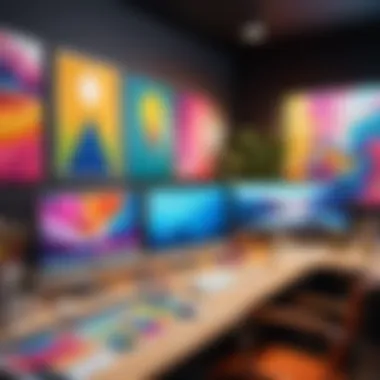

Intro
As we look around this ever-changing art landscape, it's hard not to notice the new energy radiating from its younger corners. Fresh voices are emerging, each holding a unique perspective and a flair for challenging the status quo. This article offers an in-depth exploration of some of these young contemporary artists—those who aren't just painting pictures on a canvas but are instead weaving entire narratives that reflect the complexities of our society. Their work speaks volumes, tackling not just personal influences but also broader societal issues, pressing questions that resonate at deeper levels.
In the realm of millennial and Gen Z creatives, backgrounds vary as widely as their artistic outputs. Each artist has a story to tell, influenced by factors like culture, personal experiences, and the very zeitgeist they inhabit. But what binds them together is the courage to question norms and the innovative spirit that drives them to redefine artistic expression in a modern context. This article delves into their journeys, the technologies that are changing how their work reaches audiences, and the very future of contemporary art that they are helping to shape.
From the rise of digital art to the democratization of creativity through social media, how do these tools impact the way artists create and connect? Diving deeper into these topics, we'll unravel the platforms propelling these young artists into the limelight and analyze the relationship between technology and creativity. As we embark on this exploration, we invite you to engage with each voice and perspective, understanding not just the artists but also the worldviews they offer through their work.
Foreword to Young Contemporary Artists
The realm of contemporary art is being reshaped in ways we could hardly have imagined, largely influenced by the fresh perspectives emerging from young artists today. The excitement lies in their ability to merge traditional techniques with modern narratives, breathing new life into the art world. As we delve into this topic, several elements stand out, highlighting both the importance of this article and the conditions that nurture these emerging creative voices.
Defining the Contemporary Artist
At its core, a contemporary artist is not solely defined by age or medium but by the narratives they choose to tell and the techniques they employ to share their vision. These artists actively engage with social, political, and cultural issues, often reflecting the complexities of modern life through their work. Defining them goes beyond just recognizing their youth; it's about discerning their unique ability to challenge norms and inspire change. Often, they operate in a space where technology and art intertwine, using digital tools to expand their creative reach.
The term "contemporary" implies a connection to the present. This is where these artists shine, as they draw from current events and personal experiences to formulate poignant commentary through their creations. With platforms like social media or digital galleries emerging as vital outlets for self-expression, young contemporary artists are redrawing the lines of art consumption and interaction.
Importance of Youth in Art
Youth brings vitality to any field, and art is no exception. Young artists exhibit an intrinsic ability to question the status quo, pushing the boundaries of what is widely accepted while incorporating an authenticity that resonates deeply with today’s audience. The significance of youth in art resides in their perspective; they are not constrained by traditional definitions or previous movements. Instead, they harness a sense of freedom that allows them to explore uncharted territories within their craft.
Furthermore, the importance of youth in the art world is underscored by their willingness to address pressing global issues. From climate change to identity politics, these artists serve as a mirror reflecting societal challenges, using their work as a catalyst for dialogue.
In summary, the exploration of young contemporary artists in this article aims to provide a richer understanding of how these vibrant voices are redefining artistic expression while engaging with the pressing issues of our time. Their ability to adapt to technological advancements and cultural shifts ensures that they occupy a crucial space in the evolving narrative of contemporary art.
Cultural Influences on Young Artists
In the ever-evolving landscape of contemporary art, the cultural influences that shape young artists cannot be overstated. These influences come from a myriad of sources, intertwining traditions, modernity, and the unique experiences of the artists themselves. Young contemporary artists are not just reflectors of their cultures; they actively navigate and challenge them. This section will delve into the various forces that mold these creators, examining how globalization, social media, and the imperative of diversity inform their work and artistic identities.
Globalization and Art
Globalization offers a double-edged sword for young artists today. On one hand, it opens doors to a wealth of ideas, styles, and techniques from different corners of the globe, breaking down the barriers that once confined local art scenes. Artists today draw inspiration from traditional practices in places they've never visited, all thanks to the ever-connected world we live in. This intercultural exchange can lead to a rich tapestry of styles and narratives, merging Eastern philosophies with Western techniques, for instance.
However, there is a flip side. As artists access global influences, they may inadvertently dilute their local roots. The challenge lies in achieving a balance — preserving one's cultural identity while embracing the vast assortment of artistic expressions available at their fingertips. For many, this struggle is paramount, leading to a search for authenticity amidst the constant bombardment of trending aesthetics. In summary, globalization is a catalyst for innovation but also poses questions of cultural integrity for the young artist.
Social Media as a Platform
In the digital age, social media platforms serve as the new exhibition spaces for young artists. Channels like Instagram, TikTok, and even Facebook allow them to bypass traditional gatekeepers, directly engaging with a global audience. One might say it levels the playing field, granting visibility to artists who might otherwise remain under the radar. Through these platforms, hem can showcase their process, connect with peers, and even sell their works without a third party involved.
Yet, this digital exposure comes with its issues. The pressure to conform to the algorithms can lead artists to shift their work to fit viral standards, potentially compromising their authentic voices.
It’s essential for emerging artists to navigate this new landscape mindfully. Many harness these platforms effectively, using them not just for self-promotion but as a means of creating dialogue around their art. This careful approach can foster community, support, and advocacy in ways that were difficult to achieve in decades past.
"Art is not what you see, but what you make others see." — Edgar Degas
Diversity and Intersectionality
Today's young artists are acutely aware of the complexities of identity. In a world where conversations around diversity and intersectionality are more prominent, many find themselves directly influenced by these topics in their creative processes. Emerging artists no longer work in isolation; their identities are multifaceted and fluid, encompassing race, gender, sexual orientation, and socioeconomic status, among other factors. This intersectionality enriches their narratives, allowing them to express stories that resonate with various communities.
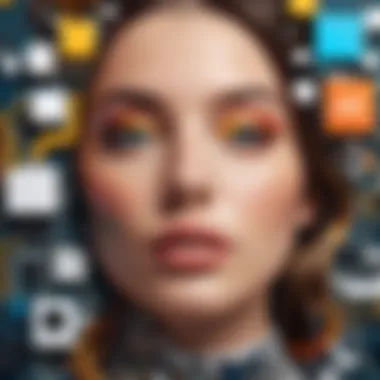

There is a distinct push against homogenized artistic narratives. For instance, a young artist might blend techniques from various cultural heritages while simultaneously addressing their experiences of marginalization. Their work often serves as a commentary on both their personal journey and the broader social tapestry. This kind of depth not only whips up a compelling visual feast but invites viewers to reflect on the societal structures that shape us all.
Tech and Art: New Mediums Emerging
The intersection of technology and art is a vibrant, ever-evolving landscape that reflects the changing times. This section dives into how young contemporary artists are harnessing technology not just as a tool, but as a canvas for expression. In this digital age, where screens dominate every aspect of life, the way artists create and share their work has transformed dramatically. The fusion of tech and art has birthed new mediums that challenge traditional conventions and invite audiences to interact with art in ways that were previously unimaginable.
Digital Art Forms
Digital art is like the chameleon of the art world, constantly adapting and thriving in the dynamic environment of modern technology. From pixel art to digital paintings, artists are expanding their creative vocabularies with software that cater to various styles and methods.
- Accessibility: With programs like Procreate and Adobe Photoshop, any artist with a tablet can bring their visions to life. This accessibility democratizes art, allowing a greater number of aspiring artists to explore their creativity.
- Creative Freedom: The flexibility that comes with digital art enables creators to experiment without the constraints of physical materials. Transforming layers, brushing effects, or altering colors with a few clicks opens avenues for artistic exploration.
- Multi-Disciplinary Practices: Many young artists blend digital art with photography, video, and even traditional painting, creating hybrid pieces that resonate across multiple mediums. This cross-pollination enriches the narratives they can tell.
As the saying goes, "the pen is mightier than the sword," and in this case, the stylus is mightier than many conventional tools combined.
Virtual Reality and Immersive Experiences
Virtual reality (VR) is not just a playground for gamers; it's becoming a substantial part of the contemporary art scene. For many young artists, VR offers a canvas that defies gravity and physical limitations.
"In the virtual realm, art transcends its static form, inviting viewers to step inside the artist's mind."
- Immersive Installations: Artists can create entire worlds for viewers to explore, turning the passive act of viewing into an active experience. Imagine walking through an underwater exhibition where you feel the current and hear the ocean's whispers.
- New Storytelling: With VR, narrative becomes multi-layered. Artists now have the chance to place viewers in various perspectives, making the experience unique to each individual. The impact of a personal encounter with art can be profound.
- Educational Potential: Art in VR can also serve as a powerful educational tool, offering interactive learning experiences that go beyond traditional art forms. This can be especially beneficial for younger generations.
The Role of NFTs in Modern Art
Non-fungible tokens (NFTs) have been the talk of the town in recent years, changing how art is bought, sold, and owned. This technology is ushering in a new era for artists, especially those who are just starting.
- Ownership and Authenticity: NFTs ensure that digital artworks have a traceable provenance. For young artists, this means they can establish themselves in the market without the risk of misattribution or forgery, unlike traditional mediums.
- Monetization Opportunities: The ability to sell digital art directly to collectors opens new revenue streams. With platforms like OpenSea and Rarible, artists can connect with buyers globally, ensuring their work has a chance to shine.
- Engagement with Fans: NFTs allow for creative ways to engage audiences, like offering exclusive experiences tied to ownership. This builds a community around the work that extends beyond the digital frame.
In an ever-changing art world, the emergence of tech-heavy mediums is rewriting the rulebook, opening doors for young artists to express themselves in transformative ways.
Themes Explored by Emerging Artists
The themes that emerging artists tackle not only capture their personal experiences but also reflect broader societal issues. These young voices are unafraid to delve into complex subjects, making their art both a personal expression and a collective commentary. This section highlights three key areas of focus—climate change, socio-political commentary, and identity and belonging—that showcase how these artists are shaping discourse through their work.
Addressing Climate Change
Artists today often use their platforms to address pressing global issues, with climate change being at the forefront. The urgency of this topic resonates deeply with a generation increasingly aware of environmental degradation and its implications. Emerging artists utilize various mediums to depict this crisis, from stark visual representations of melting ice caps to immersive installations that mimic natural landscapes on the verge of destruction.
For instance, consider the powerful work of Agnes Meyer-Brandis, who integrates exploration with ecological awareness, encouraging viewers to reflect on humanity's relationship with nature. By presenting art as a catalyst for awareness, these artists call attention to themes of sustainability and environmental stewardship.
"Art can be a bridge, connecting the public with pressing issues we face. It's like staring into a clear pool of water, and suddenly noticing the pollution below the surface."
Their contributions serve to ignite dialogue surrounding climate issues, functioning as a mirror reflecting societal neglect while simultaneously offering pathways toward holistic solutions. Moreover, these artists inspire collective action, pushing for a narrative where art transforms awareness into tangible change.
Socio-political Commentary
The socio-political landscape has never been more complex or fraught, and young artists are taking the bull by the horns. Through their work, they shed light on topics such as inequality, human rights, and justice, often using personal anecdotes to illustrate universal truths.
Inspirational figures like Diana Weymar, who creates pieces using textile art, provoke conversations about the migrant crisis. Her work, rich in texture and story, implores viewers to engage with the often-ignored struggles of marginalized communities. This interconnectedness is a hallmark of a collection that wishes to provoke thought and instigate real change, bridging gaps that the mainstream media might overlook.
In the age of instant information, these artists' ability to create commentary that resonates deeply with contemporary viewers cannot be understated. They challenge established norms and invite discourse, urging audiences to consider the socio-political implications of their own lives whilst fostering empathy for others.
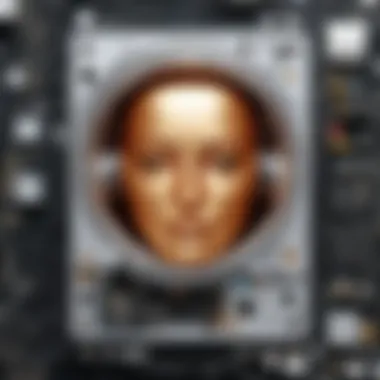
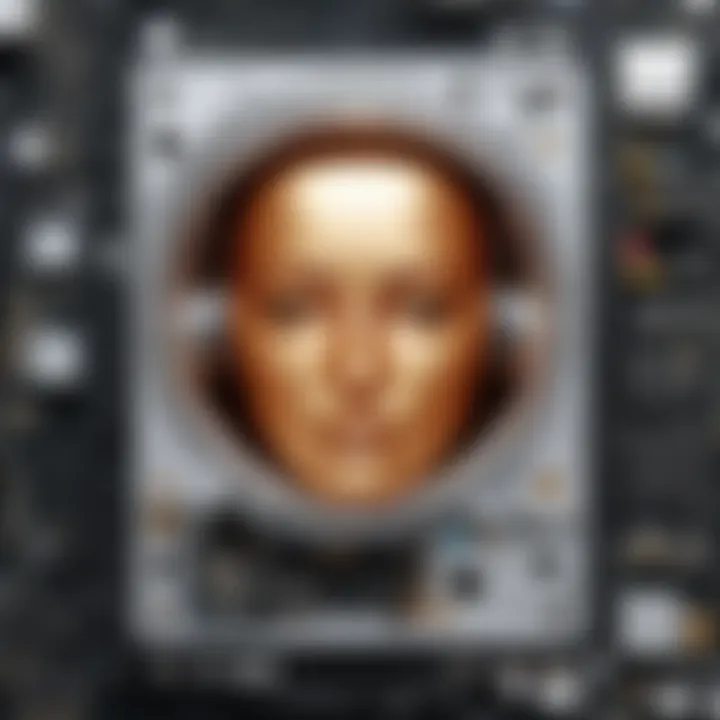
Identity and Belonging
Identity is a multifaceted theme that resonates with many of today’s emerging artists. The exploration of self—cultural background, gender, and sexuality—permeates their work, allowing audiences to engage in a journey of understanding and resonance. Artists like Janelle Monáe use their platform not just for expression but to question societal definitions of identity itself. Through art, they highlight the beautiful intricacies of individual experiences, pushing boundaries on how identity is perceived and understood.
Belonging is also a crucial aspect tackled by these artists, who often reflect on their own journeys within different communities. The art becomes a safe space for dialogue around acceptance, alienation, and cultural heritage, offering a glimpse into diverse narratives that may often go unheard.
Ultimately, the narratives explored by these artists serve a dual purpose of personal expression and broader societal insight, paving the way for future conversations that embrace understanding and inclusivity.
Emerging artists harness these themes to create not just art but profound societal commentary. As they navigate personal and collective experiences, their contributions are integral to understanding the socio-cultural dimensions of contemporary life.
Market Dynamics and Opportunities
Understanding the market dynamics within the contemporary art scene is crucial for upcoming artists navigating their careers. This section delves into how various factors influence emerging artists, the opportunities available to them, and which platforms can help bring their work to the forefront of the art world. Market dynamics are not just about the commercial aspect; they encompass a holistic view of how art is contextualized and valued in society today.
Art Fairs and Exhibitions
Art fairs and exhibitions play a pivotal role in connecting young artists with collectors, critics, and a broader audience. These events often serve as springboards for many, offering visibility that is hard to achieve through traditional avenues. Here are a few points to consider:
- Networking Opportunities: Art fairs put artists in direct contact with potential buyers and collaborators. Building relationships in these spaces can lead to unexpected opportunities.
- Market Insights: Participation allows artists to gauge what's resonating in the current market. Observing trends and audience reactions can inform future work.
- Diverse Platforms: From established names like Art Basel to smaller, localized fairs, there’s space for every artist. Each fair offers distinct audiences and insights, tailored for broader engagement.
Ultimately, being part of these events can significantly boost an artist's profile and open doors that might otherwise remain shut.
Online Galleries and Sales Platforms
The rise of digital spaces has transformed the way art is bought and sold. The emergence of online galleries and sales platforms presents young artists with unprecedented opportunities to reach a global audience. Here are some reasons why these platforms are essential:
- Accessibility: Artists no longer have to depend solely on physical galleries for exposure. Digital art platforms break geographical barriers, allowing artists to showcase their work to anyone, anywhere.
- Lower Costs: Hosting a digital gallery often incurs fewer costs than a physical space. This allows more artists to enter the market without significant financial risk.
- Data and Analytics: Many platforms provide insights into viewer behavior and sales trends. Young artists can analyze which of their works are garnering interest, aiding them in honing their style and marketing strategies.
Platforms like Saatchi Art and Artsy have innovated the way art is presented and sold, giving emerging artists new avenues for success that were previously unavailable.
Support from Art Institutions
Art institutions hold significant sway in shaping the careers of young artists. Through various initiatives, they provide essential resources and support systems that can make a real difference. Consider the following:
- Residencies and Grants: Many institutions offer programs that provide funding, studio space, and mentorship to emerging artists. These structured programs can greatly enhance an artist’s skills and visibility.
- Education and Workshops: Institutions often host workshops that cover practical skills, career development, and even business acumen which can empower young artists to better navigate their artistic and professional journeys.
- Exhibitions and Showcases: Established art institutions frequently create platforms to exhibit new talent, lending credibility and exposure that can lead to further opportunities.
"Support from established institutions can serve as a launch pad, helping young artists to position their work in an increasingly competitive landscape."
Profile of Notable Young Artists
When discussing the contemporary art scene, highlighting notable young artists is not just an exercise in admiration. It’s essential to understand how these rising talents are reshaping the landscape of art itself. Young artists are often at the forefront of experimentation and innovation, reflecting the world around us through fresh lenses.
This section aims to illustrate their significance, not merely as creators but as cultural leaders influencing dialogue around pressing social issues. Their work often serves as a mirror to societal values, showcasing diverse perspectives that challenge the status quo. As these artists gain recognition, they also pave the way for future generations and inspire budding talents. Thus, understanding their profiles becomes paramount for anyone invested in the evolution of contemporary art.
Rising Stars to Watch
Tracking the progress of emerging talents can feel like following a treasure map, with each artist offering new insights into current cultural dialogues. Consider artists like michaela angela Davis, whose work dives into race and identity. Her pieces, often engaging with found objects, create a narrative that bridges personal history and collective memory.
Another striking name is Karan Singh, known for his digital art that fuses technology with traditional narratives. Singh cleverly taps into AI to craft visual stories that resonate with younger audiences, making it clear how technology and creativity can coexist. Artists like these exemplify the interplay between heritage and modernity, ensuring that the past is never too far removed from the present.
When it comes to young creators, one can’t overlook the dynamism they bring to various mediums, from street art to installations. Their innovative techniques not only push the boundaries of conventional art forms but also challenge viewers' perceptions.
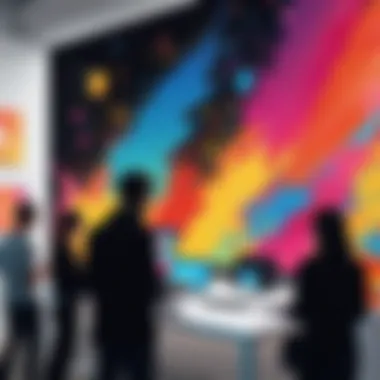
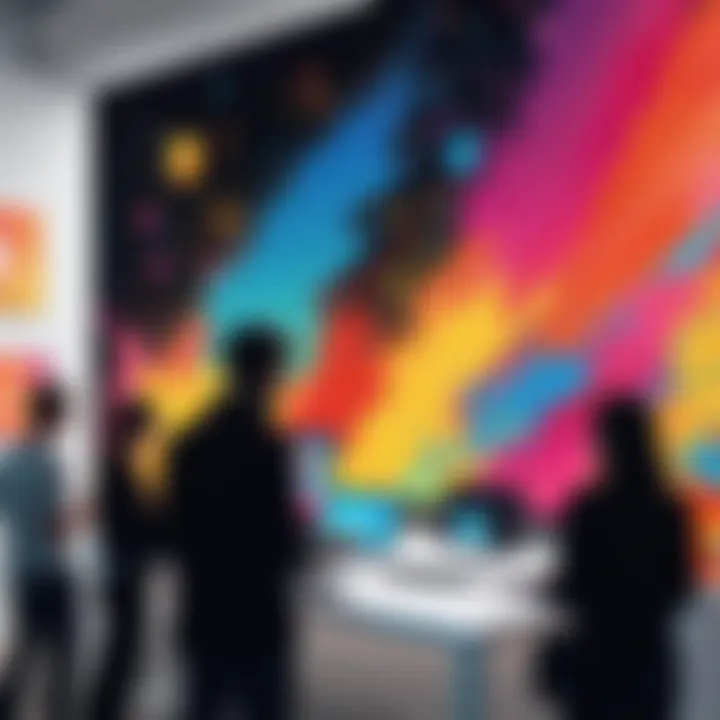
"Innovation is not just about using new tools; it's about narrating stories that need to be told."
Interviews with Emerging Artists
Engaging directly with young talent offers a glimpse into the ideation process behind their works. Interviews can reveal the inspirations, struggles, and triumphs that often remain unseen. For example, an interview with artist Sofia Almaraz highlighted the intersection of her cultural heritage and contemporary themes—a potent mix that defines much of her body of work.
Young artists frequently express how pivotal it is to find their voice in a noisy world. Through candid discussions, we can uncover the driving forces that motivate them. Many talk about the challenges of gaining visibility in a saturated market while simultaneously striving to remain true to their unique visions.
In addition to personal reflections, these conversations often illuminate broader trends in the art world. They discuss their ambitions, whether it's to address global issues or to impact local communities. What stands out in such dialogues is their desire to engage with audiences, often seeking not just to showcase art, but to provoke thought and inspire action.
As we embark on exploring this vibrant group of artists, it becomes clear that their influence will resonate far beyond their immediate circles, weaving enriching stories into the fabric of contemporary art.
The Future of Contemporary Art
The trajectory of contemporary art is not just an abstraction of styles or forms; it’s a barometer of the society in which it evolves. Young artists today are not only reflecting the world around them; they are actively engaging with and sometimes reshaping it. The future of this art form hinges on several critical factors that go beyond mere aesthetics. By examining such elements as technological advancements, socio-political shifts, and shifting audience engagement, we can gather valuable insights on what lies ahead.
The relevance of analyzing the future of contemporary art in this article is paramount. It showcases how emerging voices are instrumental in crafting narratives and expressing themes that resonate deeply with today’s audience. There’s a synergy between the artists' creative expressions and the societal changes; they are both a response to and an influencer of the zeitgeist. In this section, we will delve into predictions for upcoming trends as well as the importance of sustainability in art practices.
Predictions for Upcoming Trends
In the rapidly evolving landscape of contemporary art, certain trends have begun to surface that command attention. Some of the most noteworthy predictions for what’s on the horizon include:
- Interactivity: As digital platforms become more integral to art consumption, we can expect an increase in interactive installations where viewers are not just spectators but participants.
- Augmented Realities: Merging the physical with the digital, augmented reality art experiences will continue to grow. Imagine walking through a traditional gallery and being able to unlock additional digital layers by scanning artworks with your smartphone. This could provide deeper context and multiple interpretations simultaneously.
- Cultural Fusion: With globalization paving the way for cross-pollination of ideas, artists are increasingly drawing from various cultural backgrounds, creating hybrid forms of art that reflect diverse influences.
- Wellness Themes: There's a rising focus on mental health and wellness in contemporary works, prioritizing art's potential to heal or support well-being, which resonates with many in today’s fast-paced world.
- Experiential Art: The trend of experiencing art, rather than just observing, will gain traction. This includes immersive environments that involve all senses, creating memorable experiences that feel personal and communal.
"As we look forward, it becomes clear that art will not just document societal changes but will play a significant role in driving them."
Sustainability in Art Practices
In today's world, where environmental issues command urgent attention, sustainability is starting to weave itself into the very fabric of art-making. This growing focus on sustainable practices in art represents an ethical shift that is expected to shape the future for both artists and audiences alike.
Several aspects define sustainability in contemporary art:
- Materials and Techniques: Young artists are increasingly opting for eco-friendly materials, such as recycled items or biodegradable supplies, highlighting the need to reduce waste and promote sustainable practices.
- Community Engagement: Many artists are now integrating community participation in their projects, focusing on collaborations that not only foster connections but also promote environmental responsibility.
- Art for Awareness: Art serves as a powerful medium for raising awareness about climate change and eco-activism. Many emerging creators delve into these themes as a form of social commentary, inspiring action through their works.
- Digital Sustainability: With the rise of digital art forms, the discussion surrounding energy consumption and blockchain technology's environmental impact has become paramount. Artists are seeking ways to mitigate these issues while still embracing modern technologies.
- Long-term Vision: The artists of tomorrow are committed not just to the sustainability of their own practices but to a broader vision that integrates social justice and environmental stewardship.
As we conclude this section on the future of contemporary art, it’s clear that young artists are not merely reporting on the changing world but are actively engaged in its transformation. By predicting trends and adopting sustainable practices, they are setting a course that not only reflects a new era in art but also aims for a more conscious and connected society.
Epilogue: The Lasting Impact of Young Artists
The evolution of contemporary art is significantly shaped by the fresh perspectives and authentic voices of young artists. Their innovative spirit not only reflects personal experiences but resonates with global issues, highlighting their critical role in the modern art landscape. Recognizing these contributions sheds light on the necessity for sustained support and visibility for young creators.
Reflecting on Artistic Contributions
Young artists are often bold enough to tackle subjects that older generations might shy away from. They don’t just create art to adorn walls; they craft narratives that challenge conventions, provoke thoughts, and sometimes even incite action. For instance, the rise of artists addressing climate change has infused urgency into the art scene, encouraging conversations that extend beyond galleries.
This dynamic can be seen through various mediums, whether it’s physical installations or digital showcases. Artists like Maya Lin, with her poignant environmental installations, encapsulate how the art world can serve as a platform for advocacy. Their work resonates not just within artistic circles but also across different fields such as activism, science, and education.
“Art is not a mirror to hold up to society but a hammer with which to shape it.”
— Bertolt Brecht
Lastly, the vibrant dialogue surrounding these themes cultivates a richer cultural tapestry. The contributions of young artists encourage older generations to reconsider their own work, prompting a refreshing exchange of ideas that benefits the entire community.
Encouraging Future Generations
Supporting young artists is more than just celebrating their work; it’s about fostering the environments that enable them to shine. Art institutions and educational bodies must provide platforms that amplify these voices. Workshops, grants, and open forums can help dismantle barriers, encouraging more individuals to step into the realm of creativity.
Mentorship programs play a crucial role in this evolution. Pairing established artists with young talent creates a fertile ground for learning and growth. Knowledge transfer is vital here—while seasoned artists share their wisdom, young creators often bring a contemporary twist, keeping the dialogue fresh and relevant.
Moreover, social media acts as a powerful ally. Young artists adept at using platforms like Instagram and TikTok can reach wider audiences, showcasing their talents without waiting for traditional gatekeeping mechanisms. This access not only democratizes art but also inspires more individuals to explore their creativity.







